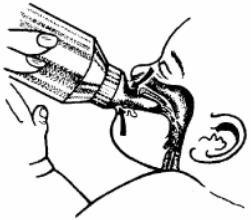a. Formula Requirements.
A formula must satisfy the infant’s requirements for water, calories, vitamins, and minerals.
Commercially prepared formulas are made according to established standards.
b. Types of Formulas.
(1) Ready-to-feed. These are liquids packaged in cans and bottles. They are convenient and considered relatively expensive.
(2) Concentrate. These are packaged in cans and are to be diluted 1:1 with water. This is less expensive.
(3) Powder. This must be mixed thoroughly with water and may have difficulty dissolving. This is considered the least expensive.
c. Formula Preparation in the Home.
(1) The choice of method is determined by the type of formula used, the safety of the home water supply, the availability of adequate refrigeration, the ability to utilize the method, and the amount of formula needed each day.
(2) The aseptic method is used when preparing formula. Cleaning the equipment before preparing the formula is essential. Formula is prepared according to directions and bottles assembled. As long as refrigeration is available, any number of bottles may be prepared.
d. Instructions for Feeding Formula.
(1) Formula at room temperature is usually well tolerated by the infant.
(2) Feeding should take place in a comfortable setting and in an unhurried manner.
(3) The newborn should be held in an elevated position (see figure 9-2). Bottles should not be propped because of the danger of the choking and aspiration.

(4) An increased amount of air may be sucked in if the infant is fed when lying flat.
(5) The bottle should be tilted to keep the nipple filled with milk/formula at all times.
(6) When the infant is held close during feedings, he gets more enjoyment from the security of being held by the parent or other person.
(7) Air bubbles can be seen going up into the bottle during feeding. This indicates that the baby is getting the formula.
(8) The infant must take at least one ounce every four hours.
e. Advantages of Formula Feeding.
(1) The mother can be sure the baby is getting enough milk for nutrition.
(2) There is an opportunity for other members of the family to get close to the baby. This allows the mother to give more of her time to her other children, to herself, or to her husband.
